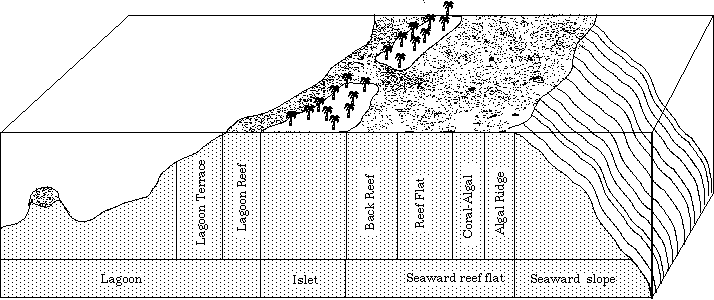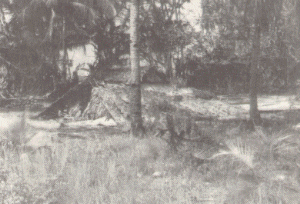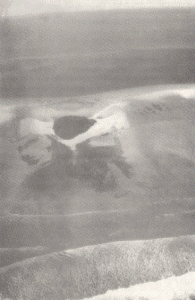

|
Essays on the Marshallese Past
Erosion on Majuro Atoll |
The atoll can be split into a northwestern, windward side and a southeastern, leeward one. The northwestern part of the atoll is characterised by large, extended reef flats with only very few islands, save for the distinct
The southern side of the atoll consisted until 1905 of a single continuous island reaching from
The atoll has only one real deep water pass, navigatable for large canoes and all European vessels: the
To understand erosion of coral atolls, we will need to have some understanding as to how the present atolls are formed. Atolls, such as Sediment deposition
This sand and rubble is constantly moved around by the waves and deposited at those points where currents and waves meet (so-called node-points), creating an area of quiet water. The quieter the water, the finer the sediment will be which can be deposited there.
A look at a map of
Apart from the islands on the leeward side, there are also islands on the windward side of the reef, but these islands consist mainly of coarser material, such as coral boulders and rubble. Visiting these islands on can see a zonation of material, with the largest rubble and boulders on the ocean side, some of them bigger than a human head, and the smallest on the lagoon side. Some islands even have small sand beaches at the lagoonside, close to the passes between the islands. At these points the current circulating in the lagoon and the water flowing through the pass into the lagoon at an incoming tide create a node point and a zone of quiet water, thus facilitating the deposition of sediment.
From the previous explanations, then, it should have become clear that any deposition of fine sediment, be it in the form of an inter-tidal sand bank or in the form of a vegetated sand cay is dependent on the direction and speed of currents and the overall patterns of wind and wave action. Therefore, a configuration of the sand cays on an atoll is always only a temporary one, prone to alterations as the current and wind/wave conditions change.

Map of Majuro Atoll showing major locations mentioned in the text.
Excluding climatic extremes, such as typhoons, natural alterations of the sand cay configuration are limited. Sand cays are sometimes known to migrate, that is they are eroded at one end and are gaining new sediment on the other end. This process is a very slow one and only perceivable over a life-time of a person.

Typical zonation pattern of a windward atoll reef-flat.

The natural environment of the Marshall Islands. Top: Aerial viewof the islands east of Rongrong from the south. The lagoon is to the left and the ocean to the right. Bottom: A traditional house has collapsed during a typhoon (Wootje Island)
In cases of extreme climatic events, such as typhoons, however, the appearance of sand cays can be altered dramatically in a very short time. To give an example: a particularly heavy typhoon hit the southern
But the course of events need not always be total destruction of an islet. The cyclone of 1918, which hit
The natural environment of the
Here the wave action washing over the island eroded the shallow organic-rich topsoil and washed it lagoonwards. Where the islet was narrow, the debris was washed into the lagoon, thus widening the islet. Where the initial islet was wide, the debris was also pushed towards the lagoon, but, since the force of the wave action diminished as it washed over the islet, it was piled up as a wall of earth close to the lagoon. Driving to Seawalls and causeways
The most dramatic and most rapid change in the configuration of sand cays is caused by human interference, for example by the construction of seawalls and, more damagingly, causeways.
Sea-walls: Let us deal first with the seawalls. It needs to be understood that apart from the wave action battering the shore, there is also an inshore current, sometimes of little strength, which runs parallel to the shore. The oceanside of the three islands
Causeways: While seawalls affect their immediate location, causeways affect entire islets. After a pass between to islets has been closed up, the in-shore currents running at the ocean side, and the currents running at the lagoon-side, no longer able to exchange water through the pass, are intesified and try to smooth off the edges of the new continuous island created by the causeway. Thus large-scale erosion is inevitable.
What happens to the eroded sand?
It needs to be added, that sediment which erodes from a sand cay or island at one point will only be lost if it falls off the reef edge on the ocean side. Given the wave patterns, this is a very rare occurrence indeed. In most cases sediment will be deposited in the form of an inter-tidal or sub-tidal sandbank close to the point where erosion takes place. Eventually it will end up at another wave-node pointØwhich may be the other end of the eroding island, or in a sediment trap. There is a small internal lagoon very close to the shore of
In the case of the causeways connecting the leeward side of
What can one do to avoid erosion caused by structures?
While natural erosion is a constantly reoccurring phenomenon which can only be stopped if the entire island is surrounded by a rip-rap, erosion caused by structures can be largely avoided. And it is simple: build appropriate seawalls and do not build any solid causeways. Rather than building a straightforward dam-type causeway, a causeway should be constructed which contains a series of culverts which permit the flow of water in and out of the lagoon and thus only minimally affect the configuration of currents and waterflows. In an ideal world one would construct a bridge, which would do the least damage, but unfortunately is also the most expensive solution.
However, incurring large scale erosion of prime land for the sake of a causeway is economically unsound, especially if a solution exists, the culverts, which combines both economical and environmental interests. In the case of

A typical small islet on the windward reef platform seen at low tide.
The islet is located on the lagoon side (top) of the reef. Sand spits are forming on both sides. Note the coral rubble ridge running from the island to the reefØs edge (bottom), and the well developed patch reef on the lagoon side of the island. (
| select from the following... | ||||||
| |
||||||
|
Digital Micronesia-An
Electronic
Library & Archive
is provided free of charge
as an advertising-free
information service
for the world community. It is being maintained by Dirk
HR Spennemann, Associate
Professor in Cultural
Heritage Management, Institute of Land, Water and Society and School
of Environmental & Information Sciences, Charles
Sturt University,
Albury, Australia. The server
space and technical support are provided by Charles
Sturt University as part of its commitment
to regional engagement. Environmental
SciencesInformation
Sciences
|
||||||